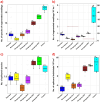Ecological restoration at pilot-scale employing site-specific rationales for small-patch degraded mangroves in Indian Sundarbans
- PMID: 38839775
- PMCID: PMC11153218
- DOI: 10.1038/s41598-024-63281-8
Ecological restoration at pilot-scale employing site-specific rationales for small-patch degraded mangroves in Indian Sundarbans
Abstract
To date, degraded mangrove ecosystem restoration accomplished worldwide primarily aligns towards rehabilitation with monotypic plantations, while ecological restoration principles are rarely followed in these interventions. However, researchers admit that most of these initiatives' success rate is not appreciable often. An integrative framework of ecological restoration for degraded mangroves where site-specific observations could be scientifically rationalized, with co-located reference pristine mangroves as the target ecosystem to achieve is currently distinctively lacking. Through this experimental scale study, we studied the suitability of site-specific strategies to ecologically restore degraded mangrove patches vis-à-vis the conventional mono-species plantations in a highly vulnerable mangrove ecosystem in Indian Sundarbans. This comprehensive restoration framework was trialed in small discrete degraded mangrove patches spanning ~ 65 ha. Site-specific key restoration components applied are statistically validated through RDA analyses and Bayesian t-tests. 25 quantifiable metrics evaluate the restoration success of a ~ 3 ha degraded mangrove patch with Ridgeline distribution, Kolmogorov-Smirnov (K-S) tests, and Mahalanobis Distance (D2) measure to prove the site's near-equivalence to pristine reference in multiple ecosystem attributes. This restoration intervention irrevocably establishes the greater potential of this framework in the recovery of ecosystem functions and self-sustenance compared to that of predominant monoculture practices for vulnerable mangroves.
Keywords: Degraded mangroves; Ecological restoration; Indian Sundarbans; Indicators of restoration & self-sustenance; Mono- & multi-species assemblage; Site-specific strategies.
© 2024. The Author(s).
Conflict of interest statement
The authors declare no competing interests.
Figures










Similar articles
-
Assessment of suitable habitat of mangrove species for prioritizing restoration in coastal ecosystem of Sundarban Biosphere Reserve, India.Sci Rep. 2022 Dec 5;12(1):20997. doi: 10.1038/s41598-022-24953-5. Sci Rep. 2022. PMID: 36470951 Free PMC article.
-
Forecasting mangrove ecosystem degradation utilizing quantifiable eco-physiological resilience -A study from Indian Sundarbans.Sci Rep. 2020 Apr 21;10(1):6683. doi: 10.1038/s41598-020-63586-4. Sci Rep. 2020. PMID: 32317761 Free PMC article.
-
A meta-analysis of the ecological and economic outcomes of mangrove restoration.Nat Commun. 2021 Aug 19;12(1):5050. doi: 10.1038/s41467-021-25349-1. Nat Commun. 2021. PMID: 34413296 Free PMC article.
-
The cost and feasibility of marine coastal restoration.Ecol Appl. 2016 Jun;26(4):1055-74. doi: 10.1890/15-1077. Ecol Appl. 2016. PMID: 27509748 Review.
-
Practical applications of soil microbiota to improve ecosystem restoration: current knowledge and future directions.Biol Rev Camb Philos Soc. 2025 Feb;100(1):1-18. doi: 10.1111/brv.13124. Epub 2024 Jul 29. Biol Rev Camb Philos Soc. 2025. PMID: 39075839 Free PMC article. Review.
References
-
- Nelson, C. R. et al. Standards of Practice to Guide Ecosystem Restoration: A Contribution to the United Nations Decade on Ecosystem Restoration 2021–2030 (FAO, SER & Gland, IUCN CEM, 2024). 10.4060/cc9106en
-
- Holling CS, Gunderson LH. Resilience and adaptive cycles. In: Gunderson LH, Holling CS, editors. Panarchy: Understanding transformations in human and natural systems. Island Press; 2002. pp. 25–62.
-
- Du Toit JT, Pettorelli N. The differences between rewilding and restoring an ecologically degraded landscape. J. Appl. Ecol. 2019;56(11):2467–2471. doi: 10.1111/1365-2664.13487. - DOI
-
- Gann GD, et al. International principles and standards for the practice of ecological restoration. Restor. Ecol. 2019;27(S1):S1–S46. doi: 10.1111/rec.13035. - DOI
-
- FAO, SER & IUCN CEM. Standards of Practice to Guide Ecosystem Restoration. A Contribution to the United Nations Decade on Ecosystem Restoration. Summary Report (Rome, 2023). 10.4060/cc5223en.
MeSH terms
Grants and funding
- BT/PR7501/BCE/8/982/2013/Department of Biotechnology, Government of India; Science and Engineering Research Board, Department of Science and Technology, Government of India
- File No. BT/PR30531/BCE/8/1496/2018/Department of Biotechnology, Government of India; Science and Engineering Research Board, Department of Science and Technology, Government of India
- EMR/2016/005262/Department of Biotechnology, Government of India; Science and Engineering Research Board, Department of Science and Technology, Government of India
LinkOut - more resources
Full Text Sources

